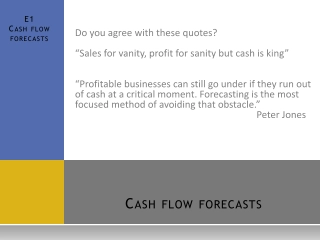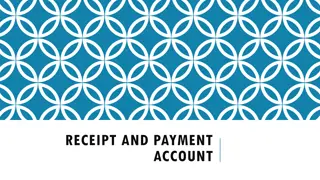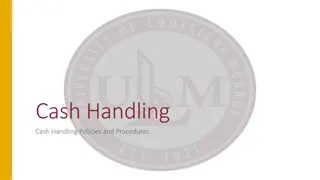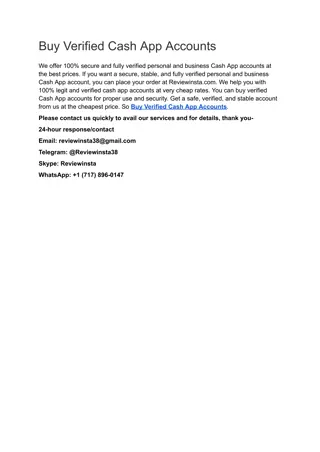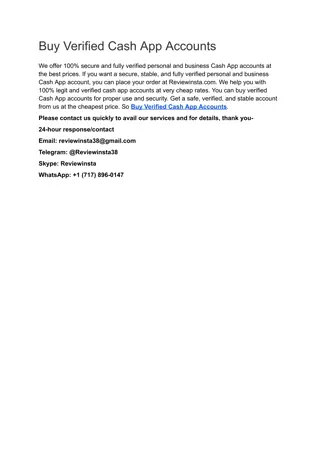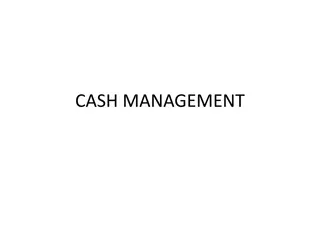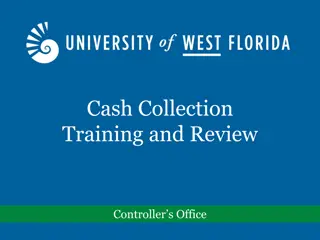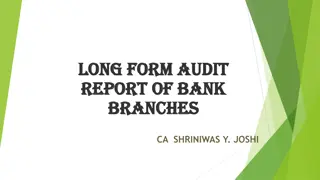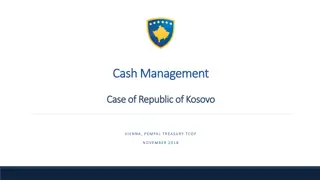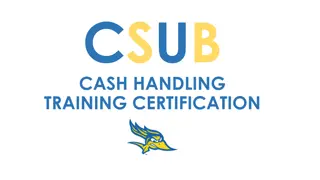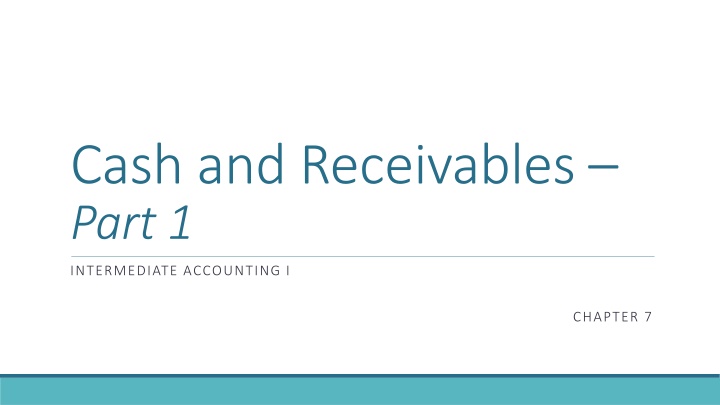
Cash and Receivables
Explore the concepts of cash management, cash equivalents, restricted cash, compensating balances, and internal controls in accounting to ensure accuracy, reliability, and safeguarding of assets. Learn how to differentiate between various types of cash assets and the importance of internal control practices for efficient operations.
Download Presentation

Please find below an Image/Link to download the presentation.
The content on the website is provided AS IS for your information and personal use only. It may not be sold, licensed, or shared on other websites without obtaining consent from the author. If you encounter any issues during the download, it is possible that the publisher has removed the file from their server.
You are allowed to download the files provided on this website for personal or commercial use, subject to the condition that they are used lawfully. All files are the property of their respective owners.
The content on the website is provided AS IS for your information and personal use only. It may not be sold, licensed, or shared on other websites without obtaining consent from the author.
E N D
Presentation Transcript
Cash and Receivables Part 1 INTERMEDIATE ACCOUNTING I CHAPTER 7
CASH CASH AND CASH EQUIVALENTS AND CASH EQUIVALENTS Cash includes: Currency and coins Unrestricted amounts on deposit in checking accounts Unrestricted amounts on deposit in savings accounts Items acceptable for deposit in bank accounts o Customer checks (bank drafts) o Certified checks o Cashier s checks o Money orders Cash equivalents include liquid investments readily convertible to a known cash amount that typically have a maturity date of three months or less from the date of purchase Examples o Money market funds o U.S. Treasury bills o Commercial paper Disclosure Notes: The company s criteria for cash equivalents must be described in a disclosure note.
RESTRICTED CASH AND COMPENSATING BALANCES RESTRICTED CASH AND COMPENSATING BALANCES Cash reported on the balance sheet under Current Assets is assumed to be available for current operations or to pay current liabilities. Restricted cash is earmarked for a specific purpose and not available for use in current operations. Restrictions on cash can be informal, arising from management intent, or might be contractually imposed, such as a compensating balance or sinking fund. New building fund Loan repayment Compensating balance a minimum or average balance required to be maintained on deposit with a financial institution Restricted cash, if material, is shown as a separate item on the balance sheet and is classified according to when the cash is intended to be used. Disclosure Notes: Any material cash restrictions are described in the disclosure notes.
INTERNAL CONTROL OF CASH INTERNAL CONTROL OF CASH Internal control refers to a company's plan to (a) encourage adherence to company policies and procedures, (b) promote operational efficiency, (c) minimize errors and theft, and (d) enhance the reliability and accuracy of accounting data. The main focus of internal controls over cash is to improve the accuracy and reliability of accounting information and to safeguard the company s assets. Below are some common practices of internal controls over cash Separation of duties - Individuals that have physical responsibility for assets should not also have access to accounting records Periodic reconciliation of book balances and bank balances All disbursements, other than very small disbursements from petty cash, should be made by check. All expenditures should be authorized before a check is prepared Checks should be signed only by authorized individuals. Forced vacations for those responsible for accounting for cash
TRADE DISCOUNTS TRADE DISCOUNTS Trade discounts allow a customer to pay an amount that is below the list price without having to publish new catalogs. Trade discounts are not recorded separately in the accounting records; they are simply used in determining the negotiated invoice price of the item purchased/sold. Example: Company A approaches Company B about purchasing 100 widgets. The widgets are listed in Company B s catalog at $10 each but Company B offers a 20% trade discount. At what amount will Company A record the purchase of 100 widgets on account? Merchandise Inventory Accounts Payable 800 List Price Less: Trade Discount Selling Price Times Num Widgets 100 Total Purchase Price $800 $ 10 2 ($10 X 20%) $ 8 800 The trade discount is not recorded separately; this is just part of the process to determine the price initially paid for the merchandise.
CASH CASH DISCOUNTS DISCOUNTS Cash discounts reduce the amount to be paid if remittance is made within a specified short period of time. Gross method records the sale at the gross price (no discount) and the discount is taken only if the receivable is paid within the discount period. When the discount is taken, it is recorded in SalesDiscounts. Net method records the sale at the net price (taking out the discount). If the receivable is paid within the discount period, no additional adjustments are required. If the customer does not pay the bill within the discount period, the difference in is recorded in a revenue account called Sales DiscountsForfeited. (Some companies treat the forfeited discount as interest revenue.)
CASH DISCOUNTS Example 1 Gross Method The Hawthorne Manufacturing Company offers credit customers a 2% cash discount if the sales price is paid within 10 days. Any amounts not paid within 10 days are due in 30 days. These repayment terms are stated as 2/10, n/30. October 5, 2013 Accounts Receivable Sales 20,000 20,000 October 14, 2013 Cash Sales Discounts (14,000 X .02) Accounts Receivable 13,720 280 On October 5, 2013, Hawthorne sold merchandise at a price of $20,000. The customer paid $13,720 ($14,000 less the 2% cash discount) on October 14 and the remaining balance of $6,000 on November 4. 14,000 November 4, 2013 Cash Accounts Receivable Draft the appropriate journal entries to record the sale and cash collection, using the gross method. 6,000 6,000
CASH DISCOUNTS Example 2 Net Method The Hawthorne Manufacturing Company offers credit customers a 2% cash discount if the sales price is paid within 10 days. Any amounts not paid within 10 days are due in 30 days. These repayment terms are stated as 2/10, n/30. October 5, 2013 Accounts Receivable (20,000 400*) Sales 19,600 19,600 October 14, 2013 Cash Accounts Receivable 13,720 On October 5, 2013, Hawthorne sold merchandise at a price of $20,000. The customer paid $13,720 ($14,000 less the 2% cash discount) on October 14 and the remaining balance of $6,000 on November 4. 13,720 November 4, 2013 Cash Accounts Receivable 6,000 Draft the appropriate journal entries to record the sale and cash collection, using the net method. 5,880 120 Sales Discounts Forfeited (Difference) *$20,000 X .02 = $400 cash discount.
Cash and Receivables Part 1 INTERMEDIATE ACCOUNTING I END OF PRESENTATION


